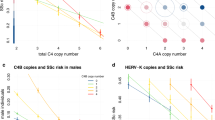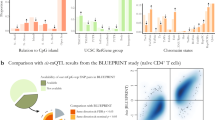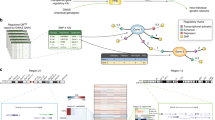Abstract
A role for T cells in the pathogenesis of multiple sclerosis (MS) is well supported, evidenced by myriad immunological studies, as well as the unequivocal genetic influence of the major histocompatibility complex (MHC). Despite many attempts, no convincing genetic associations have been made between T-cell receptor (TCR) gene loci and MS. However, these studies may not be definitive because of small sample sizes and under-representative marker coverage of the chromosomal regions being investigated. To explore potential roles between the TCR alpha locus and MS, we have genotyped a large family-based cohort, including 1360 affected individuals and 1659 of their unaffected first-degree relatives, at 40 single-nucleotide polymorphism (SNP) markers within the TCR alpha/delta locus. This represents the largest TCR alpha-MS study to date. From this screen, we identified three potential loci of interest in TCR alpha variable and constant gene regions using the transmission disequilibrium test. Although SNPs implicating each of these regions of interest will require genotyping in independent replication cohorts, these findings suggest a role for TCR gene polymorphisms in MS susceptibility. In the context of these findings we review the evidence.
This is a preview of subscription content, access via your institution
Access options
Subscribe to this journal
Receive 6 digital issues and online access to articles
$119.00 per year
only $19.83 per issue
Buy this article
- Purchase on Springer Link
- Instant access to full article PDF
Prices may be subject to local taxes which are calculated during checkout
Similar content being viewed by others
References
Sawcer S . The complex genetics of multiple sclerosis: pitfalls and prospects. Brain 2008; 131: 3118–3131.
Handel AE, Giovannoni G, Ebers GC, Ramagopalan SV . Environmental factors and their timing in adult-onset multiple sclerosis. Nat Rev Neurol 2010; 6: 156–166.
Lincoln MR, Montpetit A, Cader MZ, Saarela J, Dyment DA, Tiislar M et al. A predominant role for the HLA class II region in the association of the MHC region with multiple sclerosis. Nat Genet 2005; 37: 1108–1112.
Dyment DA, Herrera BM, Cader MZ, Willer CJ, Lincoln MR, Sadovnick AD et al. Complex interactions among MHC haplotypes in multiple sclerosis: susceptibility and resistance. Hum Mol Genet 2005; 14: 2019–2026.
Ramagopalan SV, Morris AP, Dyment DA, Herrera BM, DeLuca GC, Lincoln MR et al. The inheritance of resistance alleles in multiple sclerosis. PLoS Genet 2007; 3: 1607–1613.
Chao MJ, Barnardo MCNM, Lincoln MR, Ramagopalan SV, Herrera BM, Dyment DA et al. HLA class I alleles tag HLA-DRB1*1501 haplotypes for differential risk in multiple sclerosis susceptibility. Proc Natl Acad Sci USA 2008; 105: 13069–13074.
Lincoln MR, Ramagopalan SV, Chao MJ, Herrera BM, Deluca GC, Orton S-M et al. Epistasis among HLA-DRB1, HLA-DQA1, and HLA-DQB1 loci determines multiple sclerosis susceptibility. Proc Natl Acad Sci USA 2009; 106: 7542–7547.
Ramagopalan SV, Ebers GC . Epistasis: multiple sclerosis and the major histocompatibility complex. Neurology 2009; 72: 566–567.
Hafler DA, Compston A, Sawcer S, Lander ES, Daly MJ, De Jager PL et al. Risk alleles for multiple sclerosis identified by a genomewide study. N Engl J Med 2007; 357: 851–862.
Lundmark F, Duvefelt K, Iacobaeus E, Kockum I, Wallström E, Khademi M et al. Variation in interleukin 7 receptor alpha chain (IL7R) influences risk of multiple sclerosis. Nat Genet 2007; 39: 1108–1113.
Aulchenko YS, Hoppenbrouwers IA, Ramagopalan SV, Broer L, Jafari N, Hillert J et al. Genetic variation in the KIF1B locus influences susceptibility to multiple sclerosis. Nat Genet 2008; 40: 1402–1403.
Hoppenbrouwers IA, Aulchenko YS, Ebers GC, Ramagopalan SV, Oostra BA, van Duijn CM et al. EVI5 is a risk gene for multiple sclerosis. Genes Immun 2008; 9: 334–337.
De Jager PL, Jia X, Wang J, de Bakker PIW, Ottoboni L, Aggarwal NT et al. Meta-analysis of genome scans and replication identify CD6, IRF8 and TNFRSF1A as new multiple sclerosis susceptibility loci. Nat Genet 2009; 41: 776–782.
Baranzini SE, Wang J, Gibson RA, Galwey N, Naegelin Y, Barkhof F et al. Genome-wide association analysis of susceptibility and clinical phenotype in multiple sclerosis. Hum Mol Genet 2009; 18: 767–778.
Australia and New Zealand Multiple Sclerosis Genetics Consortium (ANZgene). Genome-wide association study identifies new multiple sclerosis susceptibility loci on chromosomes 12 and 20. Nat Genet 2009; 41: 824–828.
International Multiple Sclerosis Genetics Consortium (IMSGC). Comprehensive follow-up of the first genome-wide association study of multiple sclerosis identifies KIF21B and TMEM39A as susceptibility loci. Hum Mol Genet 2010; 19: 953–962.
Ebers G, Sadovnick A, Dyment D, Yee I, Willer C, Risch N . Parent-of-origin effect in multiple sclerosis: observations in half-siblings. The Lancet 2004; 363: 1773–1774.
Herrera BM, Ramagopalan SV, Lincoln MR, Orton SM, Chao MJ, Sadovnick AD et al. Parent-of-origin effects in MS: observations from avuncular pairs. Neurology 2008; 71: 799–803.
Hoppenbrouwers IA, Liu F, Aulchenko YS, Ebers GC, Oostra BA, van Duijn CM et al. Maternal transmission of multiple sclerosis in a Dutch population. Arch Neurol 2008; 65: 345–348.
Ramagopalan SV, Yee IM, Dyment DA, Orton S-M, Marrie RA, Sadovnick AD et al. Parent-of-origin effect in multiple sclerosis: observations from interracial matings. Neurology 2009; 73: 602–605.
Ramagopalan SV, Herrera BM, Bell JT, Dyment DA, Deluca GC, Lincoln MR et al. Parental transmission of HLA-DRB1*15 in multiple sclerosis. Hum Genet 2008; 122: 661–663.
Chao MJ, Ramagopalan SV, Herrera BM, Lincoln MR, Dyment DA, Sadovnick AD et al. Epigenetics in multiple sclerosis susceptibility: difference in transgenerational risk localizes to the major histocompatibility complex. Hum Mol Genet 2009; 18: 261–266.
Ebers GC . Environmental factors and multiple sclerosis. Lancet Neurol 2008; 7: 268–277.
Ramagopalan SV, Maugeri NJ, Handunnetthi L, Lincoln MR, Orton S-M, Dyment DA et al. Expression of the multiple sclerosis-associated MHC class II allele HLA-DRB1*1501 is regulated by vitamin D. PLoS Genet 2009; 5: e1000369.
McFarland HF, Martin R . Multiple sclerosis: a complicated picture of autoimmunity. Nat Immunol 2007; 8: 913–919.
Brucklacher-Waldert V, Stuerner K, Kolster M, Wolthausen J, Tolosa E . Phenotypical and functional characterization of T helper 17 cells in multiple sclerosis. Brain 2009; 132: 3329–3341.
Jäger A, Dardalhon V, Sobel RA, Bettelli E, Kuchroo VK . Th1, Th17, and Th9 effector cells induce experimental autoimmune encephalomyelitis with different pathological phenotypes. J Immunol 2009; 183: 7169–7177.
Du C, Liu C, Kang J, Zhao G, Ye Z, Huang S et al. MicroRNA miR-326 regulates TH-17 differentiation and is associated with the pathogenesis of multiple sclerosis. Nat Immunol 2009; 10: 1252–1259.
Gandhi KS, McKay FC, Cox M, Riveros C, Armstrong N, Heard RN et al. The multiple sclerosis whole blood mRNA transcriptome and genetic associations indicate dysregulation of specific T cell pathways in pathogenesis. Hum Mol Genet 2010; 19: 2134–2143.
Martell M, Marcadet A, Strominger J, Dausset J, Cohen D . T-cell receptor alpha genes might be involved in multiple sclerosis genetic susceptibility. C R Acad Sci III 1987; 304: 105–110.
Oksenberg JR, Gaiser CN, Cavalli-Sforza LL, Steinman L . Polymorphic markers of human T-cell receptor alpha and beta genes. Family studies and comparison of frequencies in healthy individuals and patients with multiple sclerosis and myasthenia gravis. Hum Immunol 1988; 22: 111–121.
Oksenberg JR, Sherritt M, Begovich AB, Erlich HA, Bernard CC, Cavalli-Sforza LL et al. T-cell receptor V alpha and C alpha alleles associated with multiple and myasthenia gravis. Proc Natl Acad Sci USA 1989; 86: 988–992.
Oksenberg JR, Stuart S, Begovich AB, Bell RB, Erlich HA, Steinman L et al. Limited heterogeneity of rearranged T-cell receptor V alpha transcripts in brains of multiple sclerosis patients. Nature 1990; 345: 344–346.
Hashimoto LL, Mak TW, Ebers GC . T cell receptor alpha chain polymorphisms in multiple sclerosis. J Neuroimmunol 1992; 40: 41–48.
Hillert J, Leng C, Olerup O . T-cell receptor alpha chain germline gene polymorphisms in multiple sclerosis. Neurology 1992; 42: 80–84.
Lynch SG, Rose JW, Petajan JH, Leppert M . Discordance of the T-cell receptor alpha-chain gene in familial multiple sclerosis. Neurology 1992; 42: 839–844.
Sherritt MA, Oksenberg J, de Rosbo NK, Bernard CC . Influence of HLA-DR2, HLA-DPw4, and T cell receptor alpha chain genes on the susceptibility to multiple sclerosis. Int Immunol 1992; 4: 177–181.
Eoli M, Wood NW, Kellar-Wood HF, Holmans P, Clayton D, Compston DA . No linkage between multiple sclerosis and the T cell receptor alpha chain locus. J Neurol Sci 1994; 124: 32–37.
Vandevyver C, Buyse I, Philippaerts L, Ghabanbasani Z, Medaer R, Carton H et al. HLA and T-cell receptor polymorphisms in Belgian multiple sclerosis patients: no evidence for disease association with the T-cell receptor. J Neuroimmunol 1994; 52: 25–32.
Droogan AG, Kirk CW, Hawkins SA, McMillan SA, Nevin NC, Graham CA . T-cell receptor alpha, beta, gamma, and delta chain gene microsatellites show no association with multiple sclerosis. Neurology 1996; 47: 1049–1053.
Seboun E, Robinson MA, Doolittle TH, Ciulla TA, Kindt TJ, Hauser SL . A susceptibility locus for multiple sclerosis is linked to the T cell receptor beta chain complex. Cell 1989; 57: 1095–1100.
Beall SS, Biddison WE, McFarlin DE, McFarland HF, Hood LE . Susceptibility for multiple sclerosis is determined, in part, by inheritance of a 175-kb region of the TcR V beta chain locus and HLA class II genes. J Neuroimmunol 1993; 45: 53–60.
Dyment DA, Steckley JL, Morrison K, Willer CJ, Cader MZ, DeLuca GC et al. TCR beta polymorphisms and multiple sclerosis. Genes Immun 2004; 5: 337–342.
Murphy KM, Travers P, Walport M . Janeway's Immunobiology 7th edn Garland Science: London, 2007.
Freeman JD, Warren RL, Webb JR, Nelson BH, Holt RA . Profiling the T-cell receptor beta-chain repertoire by massively parallel sequencing. Genome Res 2009; 19: 1817–1824.
Wang C, Sanders CM, Yang Q, Schroeder HW, Wang E, Babrzadeh F et al. High throughput sequencing reveals a complex pattern of dynamic interrelationships among human T cell subsets. Proc Natl Acad Sci USA 2010; 107: 1518–1523.
Utz U, Biddison WE, McFarland HF, McFarlin DE, Flerlage M, Martin R . Skewed T-cell receptor repertoire in genetically identical twins correlates with multiple sclerosis. Nature 1993; 364: 243–247.
Haegert DG, Galutira D, Murray TJ, O’Connor P, Gadag V . Identical twins discordant for multiple sclerosis have a shift in their T-cell receptor repertoires. Clin Exp Immunol 2003; 134: 532–537.
Somma P, Ristori G, Battistini L, Cannoni S, Borsellino G, Diamantini A et al. Characterization of CD8+ T cell repertoire in identical twins discordant and concordant for multiple sclerosis. J Leukoc Biol 2007; 81: 696–710.
Nikolich-Zugich J, Slifka MK, Messaoudi I . The many important facets of T-cell repertoire diversity. Nat Rev Immunol 2004; 4: 123–132.
Lefranc M-P, Lefranc G . The T Cell Receptor Factbook. Academic Press: London, 2001.
Rudolph MG, Wilson IA . The specificity of TCR/pMHC interaction. Curr Opin Immunol 2002; 14: 52–65.
Cabaniols JP, Fazilleau N, Casrouge A, Kourilsky P, Kanellopoulos JM . Most αβ T cell receptor diversity is due to terminal deoxynucleotidyl transferase. J Exp Med 2001; 194: 1385–1390.
Koop BF, Rowen L, Wang K, Kuo CL, Seto D, Lenstra JA et al. The human T-cell receptor TCRAC/TCRDC (C alpha/C delta) region: organization, sequence, and evolution of 97.6 kb of DNA. Genomics 1994; 19: 478–493.
Lefranc M-P, Giudicelli V, Ginestoux C, Jabado-Michaloud J, Folch G, Bellahcene F et al. IMGT, the international ImMunoGeneTics information system. Nucleic Acids Res 2009; 37: D1006–D1012.
Ho IC, Yang LH, Morle G, Leiden JM . A T-cell-specific transcriptional enhancer element 3′ of C alpha in the human T-cell receptor alpha locus. Proc Natl Acad Sci USA 1989; 86: 6714–6718.
Redondo JM, Hata S, Brocklehurst C, Krangel MS . A T cell-specific transcriptional enhancer within the human T cell receptor delta locus. Science 1990; 247: 1225–1229.
Mackelprang R, Livingston RJ, Eberle MA, Carlson CS, Yi Q, Akey JM et al. Sequence diversity, natural selection and linkage disequilibrium in the human T cell receptor alpha/delta locus. Hum Genet 2006; 119: 255–266.
Moffatt MF, Traherne JA, Abecasis GR, Cookson WO . Single nucleotide polymorphism and linkage disequilibrium within the TCR alpha/delta locus. Hum Mol Genet 2000; 9: 1011–1019.
Haines JL, Terwedow HA, Burgess K, Pericak-Vance MA, Rimmler JB, Martin ER et al. Linkage of the MHC to familial multiple sclerosis suggests genetic heterogeneity. The Multiple Sclerosis Genetics Group. Hum Mol Genet 1998; 7: 1229–1234.
Risch N, Merikangas K . The future of genetic studies of complex human diseases. Science 1996; 273: 1516–1517.
Sadovnick AD, Risch NJ, Ebers GC . Canadian collaborative project on genetic susceptibility to MS, phase 2: rationale and method. Canadian Collaborative Study Group. Can J Neurol Sci 1998; 25: 216–221.
Spielman RS, McGinnis RE, Ewens WJ . Transmission test for linkage disequilibrium: the insulin gene region and insulin-dependent diabetes mellitus (IDDM). Am J Hum Genet 1993; 52: 506–516.
Spielman RS, Ewens WJ . The TDT and other family-based tests for linkage disequilibrium and association. Am J Hum Genet 1996; 59: 983–989.
Bronson PG, Caillier S, Ramsay PP, McCauley JL, Zuvich RL, De Jager PL et al. CIITA variation in the presence of HLA-DRB1*1501 increases risk for multiple sclerosis. Hum Mol Genet 2010; 19: 2331–2340.
Hallmayer J, Faraco J, Lin L, Hesselson S, Winkelmann J, Kawashima M et al. Narcolepsy is strongly associated with the T-cell receptor alpha locus. Nat Genet 2009; 41: 708–711.
Fontana A, Gast H, Reith W, Recher M, Birchler T, Bassetti CL . Narcolepsy: autoimmunity, effector T cell activation due to infection, or T cell independent, major histocompatibility complex class II induced neuronal loss? Brain 2010; 133: 1300–1311.
Mignot E . Genetic and familial aspects of narcolepsy. Neurology 1998; 50: S16–S22.
Bassing CH, Tillman RE, Woodman BB, Canty D, Monroe RJ, Sleckman BP et al. T cell receptor (TCR) alpha/delta locus enhancer identity and position are critical for the assembly of TCR delta and alpha variable region genes. Proc Natl Acad Sci USA 2003; 100: 2598–2603.
Purcell S, Neale B, Todd-Brown K, Thomas L, Ferreira MAR, Bender D et al. PLINK: a tool set for whole-genome association and population-based linkage analyses. Am J Hum Genet 2007; 81: 559–575.
Acknowledgements
This study was supported by the Multiple Sclerosis Society of Canada Scientific Research Foundation, the Multiple Sclerosis Society of Great Britain and Northern Ireland and the Natural Sciences and Engineering Research Council of Canada. We thank all patients who generously participated in this study and physicians participating in the CCPGSMS. Experiments performed for this investigation comply with current guidelines and ethics.
Author information
Authors and Affiliations
Corresponding authors
Ethics declarations
Competing interests
The authors declare no conflict of interest.
Additional information
Supplementary Information accompanies the paper on Genes and Immunity website
Supplementary information
Rights and permissions
About this article
Cite this article
Watson, C., Para, A., Lincoln, M. et al. Revisiting the T-cell receptor alpha/delta locus and possible associations with multiple sclerosis. Genes Immun 12, 59–66 (2011). https://doi.org/10.1038/gene.2010.65
Received:
Accepted:
Published:
Issue Date:
DOI: https://doi.org/10.1038/gene.2010.65



